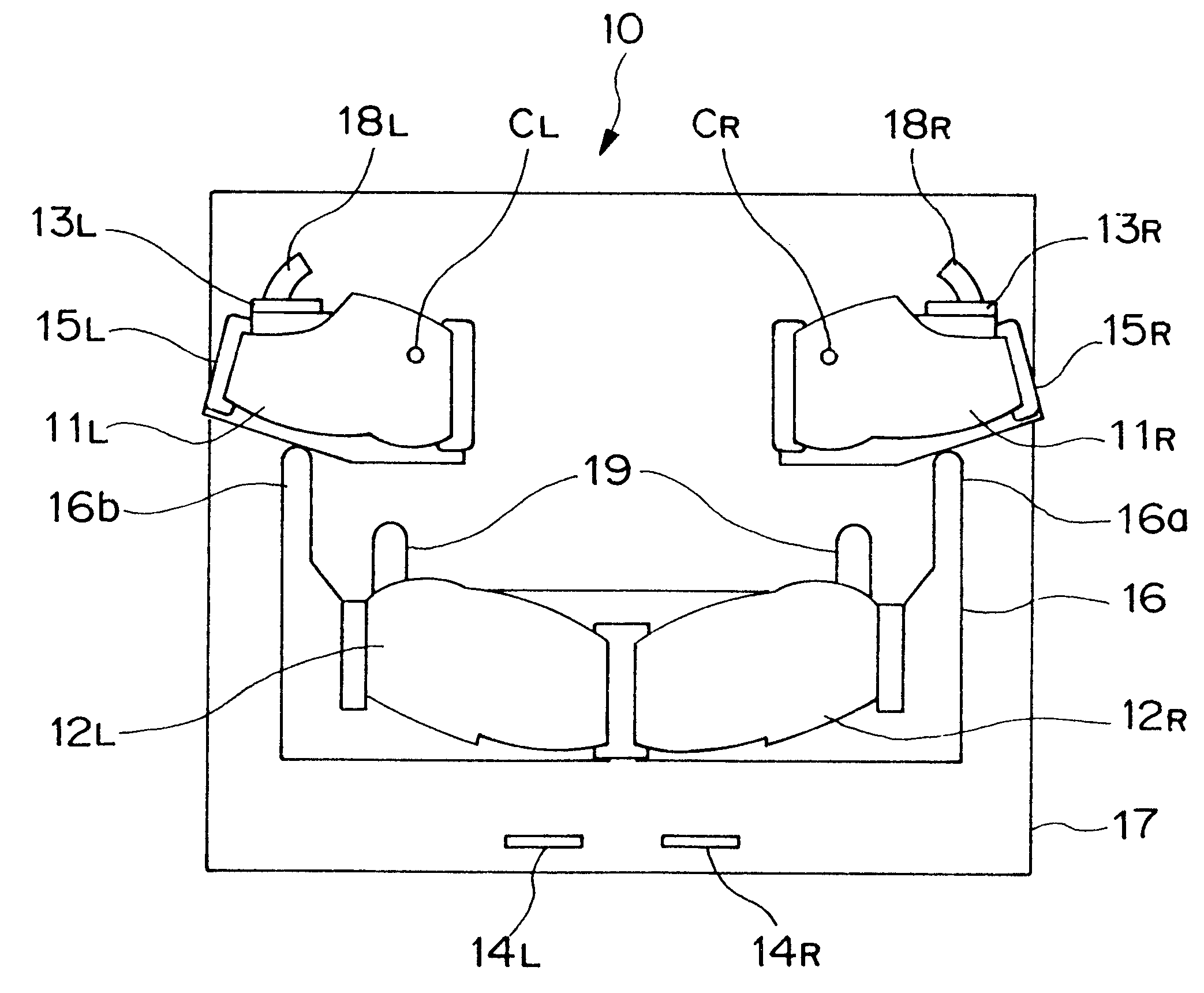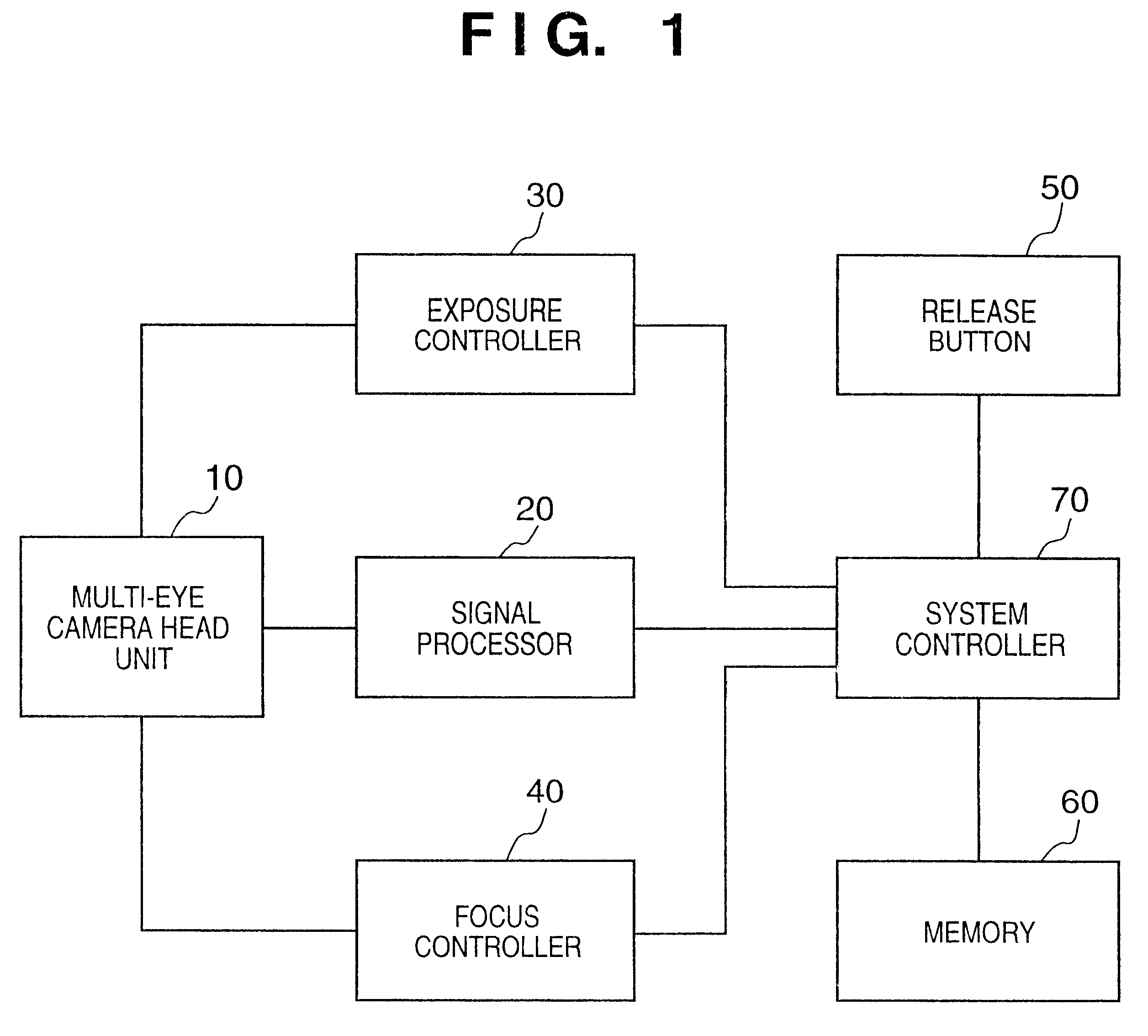Multi-eye image sensing apparatus
a multi-eye, image sensing technology, applied in the direction of instruments, optical elements, panoramic photography, etc., can solve the problems of insufficient stereoscopic sense, large apparatus, and lens interference of respective image sensing optical systems, so as to reduce the number of building components and compact arrangement
- Summary
- Abstract
- Description
- Claims
- Application Information
AI Technical Summary
Benefits of technology
Problems solved by technology
Method used
Image
Examples
first embodiment
[First Embodiment]
FIG. 1 is a block diagram showing the arrangement of a multi-eye image sensing apparatus of the first embodiment.
Referring to FIG. 1, reference numeral 10 denotes a multi-eye camera head unit, which senses images of an object, and outputs image signals. Reference numeral 20 denotes a signal processor for converting image signals obtained by the multi-eye camera head unit 10 into image data of, e.g., JPEG (Joint Photographer Expert Group) or the like. Reference numeral 30 denotes an exposure controller for controlling the exposure values of right and left image sensing systems of the multi-eye image camera head unit 10 in correspondence with the brightness of the object.
Reference numeral 40 denotes a focus controller for controlling focusing on the object. Reference numeral 50 denotes a release button. Reference numeral 60 denotes a memory for storing image data. Reference numeral 70 denotes a system controller for controlling the operation of the overall multi-eye ...
second embodiment
[Second Embodiment]
FIG. 7 is a block diagram showing the arrangement of a multi-eye image sensing apparatus of the second embodiment.
Referring to FIG. 7, reference numeral 10A denotes a multi-eye camera head unit which senses images of an object, and outputs image signals.
Reference numeral 20 denotes a signal processor for converting image signals obtained by the multi-eye camera head unit 10A into image data of, e.g., JPEG or the like. Reference numeral 30 denotes an exposure controller for controlling the exposure values of right and left image sensing systems of the multi-eye image camera head unit 10A in correspondence with the brightness of the object. Reference numeral 40 denotes a focus controller for controlling focusing on the object.
Reference numeral 50 denotes a release button. Reference numeral 60 denotes a memory for storing image data. Reference numeral 70 denotes a system controller for controlling the operation of the overall multi-eye image sensing apparatus. Refere...
second embodiments
The first and second embodiments provide multi-eye image sensing apparatuses which can respectively change the convergence angle and base length. However, these functions may be combined to construct a multi-eye image sensing apparatus which can change both the convergence angle and base length.
The image sensing systems that use offaxial optical system blocks as the optical elements 11R, 11L, 12R, and 12L have been exemplified. Since high degree of freedom in layout of the entrance and exit reference axes is realized when offaxial optical system blocks are included, some of the optical elements 11R, 11L, 12R, and 12L may be replaced by conventional coaxial optical system blocks.
In this manner, since each of the right and left image sensing systems includes at least one prism as an offaxial optical system block, which includes an offaxial reflecting surface that is an asymmetric aspherical surface as a building component, and has a refractive power that can form a real image as a who...
PUM
 Login to View More
Login to View More Abstract
Description
Claims
Application Information
 Login to View More
Login to View More - R&D
- Intellectual Property
- Life Sciences
- Materials
- Tech Scout
- Unparalleled Data Quality
- Higher Quality Content
- 60% Fewer Hallucinations
Browse by: Latest US Patents, China's latest patents, Technical Efficacy Thesaurus, Application Domain, Technology Topic, Popular Technical Reports.
© 2025 PatSnap. All rights reserved.Legal|Privacy policy|Modern Slavery Act Transparency Statement|Sitemap|About US| Contact US: help@patsnap.com



